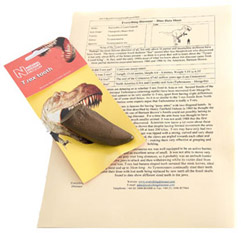Big Meat-eaters Roamed Cretaceous Japan
Teeth are the hardest parts of vertebrates bodies, the enamel is readily fossilised if conditions are favourable and fossil teeth can provide palaeontologists with a great deal of information about extinct animals. More information regarding prehistoric life in what is now Japan was unveiled this week with the announcement of the discovery of the largest dinosaur tooth known to date from this country.
Carnivorous Dinosaur Tooth
An amateur palaeontologist called Satoshi Utsunomiya had found the single tooth whilst on a fossil hunting trip in Hakusan, Ishikawa Prefecture.
The tooth is clearly from a meat-eating dinosaur, a theropod and was found in sediments approximately 130 million years old, dating the discovery to the early Cretaceous (Hauterivian/Barremian faunal stages). The tooth is extremely well preserved and measures 8.2 cm long and is 2.8 cm wide at its widest part.
The tooth is a broken tooth, that means that the root is missing. Two basic types of fossil teeth are found, those with the roots and those without. The teeth with roots probably fell out of the animal’s skull with the animal already long dead, the flesh around the gums rotting away and eventually the teeth including their roots fall out.
Teeth like these are often found in association with other bone and teeth material. In contrast, broken teeth like the one found in Japan are associated with tooth loss whilst the animal was very much alive. A tooth may have been shed whilst this carnivore was feeding or fighting. Dinosaurs were capable of replacing their teeth throughout their lives, as teeth were worn, broken or shed new teeth erupted on the inside of the old ones.
Dinosaur Tooth
According to the National Museum of Nature and Science, the largest tooth found previously in Japan is the 7.5 cm long Mifuneryu, which was unearthed in Mifunemachi, Kumamoto Prefecture, in 1979.
One expert says the Hakusan tooth is “the largest specimen found in perfect condition in this country.” The specimen has been authenticated by the Palaeontological Society of Japan.
The tooth is certainly typical of a large theropod, being generally re-curved with blade-like denticles (serrations) along the front and back edges. Teeth variations can help scientists identity the family of the dinosaur that the tooth may have come from. For instance, Allosauridae and Carcharodontosauridae family members tend to have large, slightly compressed teeth with even-sized serrations. Tyrannosaur teeth tend to be thicker, “D” shaped in cross section and more coarsely serrated. The serrated edges helped these meat-eaters to cut into the meat of the victims very efficiently as well as helping to maintain a grip on any struggling prey.
Large Theropod Tooth
Team members at Everything Dinosaur have been lucky enough to examine a number of large theropod teeth including tyrannosaur teeth found in Canada. One particular specimen was so well preserved that the coarse serrations along the edges could clearly be seen without any preparation.
Although, rare in the fossil record casts of fossil teeth can be purchased so that enthusiasts can own for themselves a piece of dinosaur dentition, for example, Everything Dinosaur offers for sale a replica of a Tyrannosaurus rex tooth, one of the very first ever identified as belonging to a T. rex. It is a copy of a tooth from the right, lower jaw.
The Tyrannosaurus rex Tooth from Everything Dinosaur
Picture credit: Everything Dinosaur
To view the tooth and other prehistoric animal items in stock: Visit Everything Dinosaur.
There have been a number of recent dinosaur discoveries in Japan, including the unearthing of an enormous thigh bone of a large plant-eating dinosaur: Huge Sauropod Femur found in Japan.
In addition, remains of Late Cretaceous dinosaurs have also been discovered, including evidence of duck-billed dinosaurs (hadrosaurs): Duck-Billed dinosaur discovered in Japan.







8.5 centimeter teeth ? Surely the molars of these newly discovered ( mega) sauropods, had to go 12-14 inches with root.